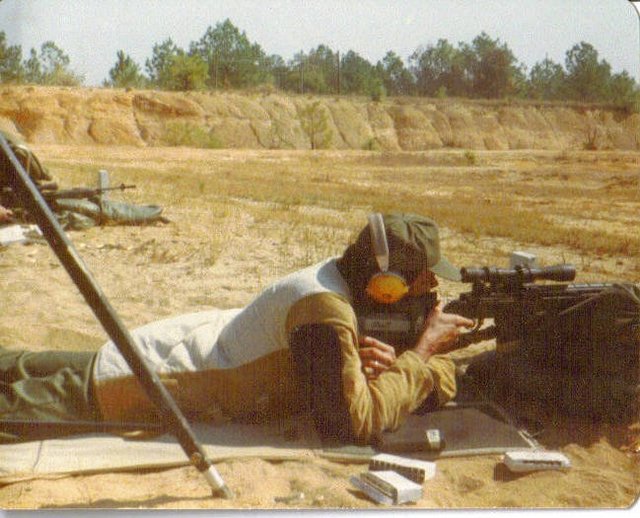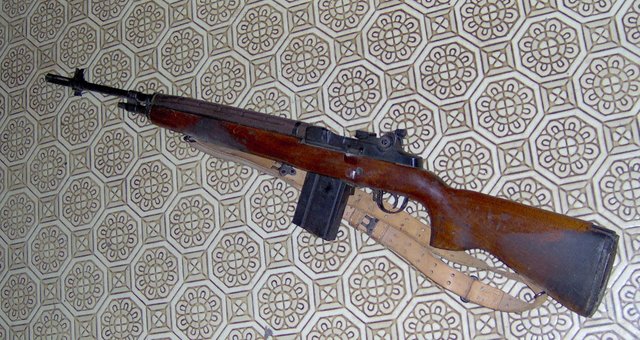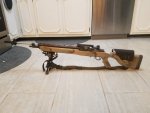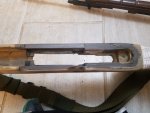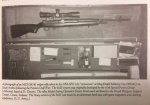I've become enthralled with the M14 and its sniper variants. In fact, I have a round-about, I was there, connection to the XM25. The XM25 sniper system...the successor to the M21 system, was largely developed by SFC Tom Kapp of 10th SFG (A). SFC Kapp left ODA 075, right before I became Team Leader, to work on the development of the M25 system. Below is a pic of my XM25. It is a Springfield M1A Super match with Leupold Mk 4 LR/T. These retail for $3708, but I found mine at a pawn shop on-line for a little more than half that. It's always a risk buying a smoking deal from an on-line pawn shop, but I took the risk. I fired 20 rounds of Hirtenberger .308 to foul the barrel and sight in the scope. Below are the 25th through 30th shots fired at 100 yds using Federal Gold Medal Match.
[IMG2=JSON]{"data-align":"none","data-size":"full","src":"http:\/\/i.imgur.com\/FcqInZzl.jpg"}[/IMG2]
That's more than satisfactory. Of course, the Super Match is no ordinary M1A, here are the details:
The rear-lugged action of the Super Match M1A™ is masterfully glass bedded into an oversized stock. At the core of the Super Match M1A™’s unparalleled performance is the heavy match Douglas barrel. These oversized match barrels are the heaviest possible match-legal barrels that can fit in the M1A™, and they feature a 1 in 10 twist that gives optimal performance for the .308 match bullets we recommend. The Super Match M1A™ also features a National Match recoil spring guide and a match-tuned gas cylinder. Add the match tuned 4.5 – 5lb two-stage trigger, .0595” hooded rear aperture (½ MOA adjustable) and .062” front sight, and the resultant rifle will blow away the competition with its precision and accuracy.
Here's a pic of my XM25
[IMG2=JSON]{"data-align":"none","data-size":"full","src":"http:\/\/i.imgur.com\/1YTE3lAl.jpg"}[/IMG2]
I'm also working on the Vietnam era M14 sniper system with ART II scope. The basis for that will be a Springfield M1A National Match. Here are some historical pics of the XM25 and its development.
SFC Kapp with M25 with Leupold 10x Ultra scope, M3 turrets. The Ultra is basically an early M4 LR/T [IMG2=JSON]{"data-align":"none","data-size":"full","src":"http:\/\/i.imgur.com\/3VF6GDL.jpg"}[/IMG2]
Yes, I have an AN/PVS-4 [IMG2=JSON]{"data-align":"none","data-size":"full","src":"http:\/\/i.imgur.com\/VZqb61Jh.jpg"}[/IMG2]
This is what we used on our M21's...Sionics Sound Supressor [IMG2=JSON]{"data-align":"none","data-size":"full","src":"http:\/\/i.imgur.com\/ElJJ6Nn.jpg"}[/IMG2]
Bausch and Lomb 10x [IMG2=JSON]{"data-align":"none","data-size":"full","src":"http:\/\/i.imgur.com\/bCs3WYQ.jpg"}[/IMG2]
[IMG2=JSON]{"data-align":"none","data-size":"full","src":"http:\/\/i.imgur.com\/9UtVLqWl.jpg"}[/IMG2]
SFC Kapp passed away as a result of injuries sustained as related in the article below. I found this on the M14 forum from an un-named source and all I can say is the story jives with the facts as I had related to me from my 075 team mates.
A Little M25 History.........
...........in case anybody is interested. Back in 1985 I graduated from the SFQC and was assigned to the 10th SFG(A) at Ft. Devens, MA. One of the guys I graduated with was SFC Tom Kapp. He was later assigned as I recall to the 3rd Battalion. I didn't really know him well in 85' but he was a friendly, affable guy and we used to talk guns when we ran into each other.
Around 1986 as I remember, 3rd Bn. engaged a number of their SF Teams (ODA's) in what was called the "Lighweight Rations Test". Back then we were still deep in the Cold War. The mission of the 10th SFG was to drop most of the group behind the lines into (essentially a suicide mission and thank God it never came to that) the Warsaw Pact and conduct missions. Some of those missions could go on for weeks if not months and it would be very difficult for these teams to jump/carry in enough rations. Natick Lab was just down the road towards Boston and they would dream up all sorts of gadgets, devices, and foods for us to try out. They came up with "Lightweight Rations" which were VERY small, highly concentrated food rations, like a days worth would fit in the palm of your hand. A number of ODA's were in isolation at Ft. Devens and were planning for an extended training mission where they would be inserted into the White Mountains of Vermont. While at Devens in the ISOPREP area (WWII barracks), they would eat three normal meals a day of food mermited from the messhall. Following their meals they would play a small video game that would test reaction time, judgement, and memory. Then, when they were inserted into the field, they would play the same game but would be eating the lightweight rations. The game had a memory chip that would record their performance which would later be analyzed to see the effect of the new rations. I remember seeing the rations-they were about 2/3's the size of a Snickers bar-it was also the first time I saw those small bottles of Tabasco sauce now standard in MRE's. I thought those little bottles were kinda cool and I asked one of the guys if I could have one. He said, "Hell no! I don't have enough to eat as it is!".
Well, the teams were inserted, and the guys started to live off them. Soon they realized that this just flat out wasn't enough food. A lotta guys said screw it, ate up the rations, and then went begging for food from locals they could find in the mountains. Some guys however sucked it up and followed the parameters of the test. Tom Kapp was one of those. The problem he later told me, was that when some people are severely malnourished, their system never really recovers from it. The starvation diet I understand negatively impacted upon Kapps health-so much so that he could not remain on a Team. So, they put him on the "Sniper Committee" also called the "SOTIC Committee" (Special Operations Target Interdiction Committee). A little after Kapp was put on SOTIC, I was on the staff of the 2nd Bn. I ran into Kapp, we started talking, and he invited me over to their shop which I accepted.
SOTIC was ran at the time by MSGT Amelung (don't recall his first name) but he was getting ready to retire and then Kapp would take over. Their shop was located by the 10th SFG motor pool in a WWII barracks. Most of their work was done on the ground floor. After that I used hang around occasionally, pick their brains, and just learn about what they were doing. At the time the US Army didn't really have a sniper rifle worth a [IMG2=JSON]{"data-align":"none","data-size":"full","src":"http:\/\/m14forum.com\/images\/smilies\/censored.gif"}[/IMG2]
. The few M-21's I saw were kinda beat to snot. SOTIC was building M-25's (an unofficial designation in their shop) essentially one rifle at a time and also learning and developing new techniques while they went along. Also Kapp had done a lot of High Power rifle shooting and used that as a base of knowledge. Here's something y'all may not know. Technically NONE of the M-14's they converted to M-25's were actually on the 10th Groups property book i.e. they were not "owned" by us.
10th SFG at Devens was not authorized to have but two M-14's, one for each battalion as training weapons. And the Army wouldn't budge on the MTOE (Modified Table of Organization and Equipment). So, to get around this, a "drug deal" was made between the Post Commander and 10th Group. You see the Post had an honor guard, and the honor guard was allowed to have M-14's. There was no limit to the number they could have. So, the post would order X number of M-14's from Anniston, they would be placed on the post property book, and then they would be hand receipted to 10th SFG. The only parts Kapp and crew (after Kapp took over it was just him and a SSG who were building rifles-there was also another MSGT there for a while but Kapp was in charge) would keep was the receiver, trigger group, gas system, oprod, and flash suppressor.
I remember Kapp telling me how they tried out some of the M-14/M1A scope mounts. He said they liked the concept of the ARMS mount a lot because it would have been nice to easily swap a rifle scope for an AN/PVS-4 scope and back again. However when they fired the rifle, the scope mount fell off after 27 rounds. They also tested the Springfield Armory mount but that wasn't rugged enough. At the time we jumped exposed weapons i.e. NO padded weapons case. Any scope mount would have to be damn rugged and not lose zero (we found out just how flimsy the M-16A2 rear sight was when jumping them exposed as well). Well, Kapp related to me how he sat down and designed a new type of M-14 mount, gave it to Brookfield and said, "You make this mount and we'll buy it". He also told me he couldn't take credit for it because he was worried about a possible conflict of interest situation.
So, Kapp was cranking out M-25's but it wasn't something that could be done quickly and the plan was to have at least one, if not two snipers with a sniper rifle on each ODA. My battalion commander for instance believed that each 18B on the team (there are two) should be a sniper. Nice thought but not everybody, even an SF weapons NCO has what it takes to be a sniper. So, what to do? Around the winter of 1988, I was in the battalion arms room and the armorer hands me a BRAND NEW M-1D. I mean not a scratch on it. Now, back in 1988 real M-1D's were scarce. If you saw one it was probably surplused from Israel and somewhat beat up. The cone flash hider was still in the cardboard can. It was niiiiiiiiiiiiiiiice. I asked the armorer where it came from and he said, "We pulled it outa POMCUS stocks". POMCUS stands for Prepositioning Of Materiel Configured to Unit Sets". POMCUS for SF was a huge warehouse in England. From what I was told by a few guys that actually had been there, it was like that warehouse in the last scene of 'Raiders of the Lost Ark". It was this mythical supply dump/bunker where everything SF guys would need to fight WWIII, from Rolex watches to boots was stored. I asked him how many M-1D's we got and he said, "2nd Battalion has 24, 3rd has 23". I'm going "Wowwwwwwww!" Then he says, "guess how many are still in POMCUS?". I think for a few seconds and say, "Uh, a hundred?" He grins and says "1500............." When I heard that I was speechless. Anyway these were supposed to be issued as Team sniper rifles. And while they were very neat rifles, frankly I never though much of an M-1D as a sniperrifle-I mean in 1988 it would have been like issuing Pershing tanks to the 11 ACR at the Fulda Gap.
[IMG2=JSON]{"data-align":"none","data-size":"full","src":"http:\/\/i.imgur.com\/FcqInZzl.jpg"}[/IMG2]
That's more than satisfactory. Of course, the Super Match is no ordinary M1A, here are the details:
The rear-lugged action of the Super Match M1A™ is masterfully glass bedded into an oversized stock. At the core of the Super Match M1A™’s unparalleled performance is the heavy match Douglas barrel. These oversized match barrels are the heaviest possible match-legal barrels that can fit in the M1A™, and they feature a 1 in 10 twist that gives optimal performance for the .308 match bullets we recommend. The Super Match M1A™ also features a National Match recoil spring guide and a match-tuned gas cylinder. Add the match tuned 4.5 – 5lb two-stage trigger, .0595” hooded rear aperture (½ MOA adjustable) and .062” front sight, and the resultant rifle will blow away the competition with its precision and accuracy.
Here's a pic of my XM25
[IMG2=JSON]{"data-align":"none","data-size":"full","src":"http:\/\/i.imgur.com\/1YTE3lAl.jpg"}[/IMG2]
I'm also working on the Vietnam era M14 sniper system with ART II scope. The basis for that will be a Springfield M1A National Match. Here are some historical pics of the XM25 and its development.
SFC Kapp with M25 with Leupold 10x Ultra scope, M3 turrets. The Ultra is basically an early M4 LR/T [IMG2=JSON]{"data-align":"none","data-size":"full","src":"http:\/\/i.imgur.com\/3VF6GDL.jpg"}[/IMG2]
Yes, I have an AN/PVS-4 [IMG2=JSON]{"data-align":"none","data-size":"full","src":"http:\/\/i.imgur.com\/VZqb61Jh.jpg"}[/IMG2]
This is what we used on our M21's...Sionics Sound Supressor [IMG2=JSON]{"data-align":"none","data-size":"full","src":"http:\/\/i.imgur.com\/ElJJ6Nn.jpg"}[/IMG2]
Bausch and Lomb 10x [IMG2=JSON]{"data-align":"none","data-size":"full","src":"http:\/\/i.imgur.com\/bCs3WYQ.jpg"}[/IMG2]
[IMG2=JSON]{"data-align":"none","data-size":"full","src":"http:\/\/i.imgur.com\/9UtVLqWl.jpg"}[/IMG2]
SFC Kapp passed away as a result of injuries sustained as related in the article below. I found this on the M14 forum from an un-named source and all I can say is the story jives with the facts as I had related to me from my 075 team mates.
A Little M25 History.........
...........in case anybody is interested. Back in 1985 I graduated from the SFQC and was assigned to the 10th SFG(A) at Ft. Devens, MA. One of the guys I graduated with was SFC Tom Kapp. He was later assigned as I recall to the 3rd Battalion. I didn't really know him well in 85' but he was a friendly, affable guy and we used to talk guns when we ran into each other.
Around 1986 as I remember, 3rd Bn. engaged a number of their SF Teams (ODA's) in what was called the "Lighweight Rations Test". Back then we were still deep in the Cold War. The mission of the 10th SFG was to drop most of the group behind the lines into (essentially a suicide mission and thank God it never came to that) the Warsaw Pact and conduct missions. Some of those missions could go on for weeks if not months and it would be very difficult for these teams to jump/carry in enough rations. Natick Lab was just down the road towards Boston and they would dream up all sorts of gadgets, devices, and foods for us to try out. They came up with "Lightweight Rations" which were VERY small, highly concentrated food rations, like a days worth would fit in the palm of your hand. A number of ODA's were in isolation at Ft. Devens and were planning for an extended training mission where they would be inserted into the White Mountains of Vermont. While at Devens in the ISOPREP area (WWII barracks), they would eat three normal meals a day of food mermited from the messhall. Following their meals they would play a small video game that would test reaction time, judgement, and memory. Then, when they were inserted into the field, they would play the same game but would be eating the lightweight rations. The game had a memory chip that would record their performance which would later be analyzed to see the effect of the new rations. I remember seeing the rations-they were about 2/3's the size of a Snickers bar-it was also the first time I saw those small bottles of Tabasco sauce now standard in MRE's. I thought those little bottles were kinda cool and I asked one of the guys if I could have one. He said, "Hell no! I don't have enough to eat as it is!".
Well, the teams were inserted, and the guys started to live off them. Soon they realized that this just flat out wasn't enough food. A lotta guys said screw it, ate up the rations, and then went begging for food from locals they could find in the mountains. Some guys however sucked it up and followed the parameters of the test. Tom Kapp was one of those. The problem he later told me, was that when some people are severely malnourished, their system never really recovers from it. The starvation diet I understand negatively impacted upon Kapps health-so much so that he could not remain on a Team. So, they put him on the "Sniper Committee" also called the "SOTIC Committee" (Special Operations Target Interdiction Committee). A little after Kapp was put on SOTIC, I was on the staff of the 2nd Bn. I ran into Kapp, we started talking, and he invited me over to their shop which I accepted.
SOTIC was ran at the time by MSGT Amelung (don't recall his first name) but he was getting ready to retire and then Kapp would take over. Their shop was located by the 10th SFG motor pool in a WWII barracks. Most of their work was done on the ground floor. After that I used hang around occasionally, pick their brains, and just learn about what they were doing. At the time the US Army didn't really have a sniper rifle worth a [IMG2=JSON]{"data-align":"none","data-size":"full","src":"http:\/\/m14forum.com\/images\/smilies\/censored.gif"}[/IMG2]
. The few M-21's I saw were kinda beat to snot. SOTIC was building M-25's (an unofficial designation in their shop) essentially one rifle at a time and also learning and developing new techniques while they went along. Also Kapp had done a lot of High Power rifle shooting and used that as a base of knowledge. Here's something y'all may not know. Technically NONE of the M-14's they converted to M-25's were actually on the 10th Groups property book i.e. they were not "owned" by us.
10th SFG at Devens was not authorized to have but two M-14's, one for each battalion as training weapons. And the Army wouldn't budge on the MTOE (Modified Table of Organization and Equipment). So, to get around this, a "drug deal" was made between the Post Commander and 10th Group. You see the Post had an honor guard, and the honor guard was allowed to have M-14's. There was no limit to the number they could have. So, the post would order X number of M-14's from Anniston, they would be placed on the post property book, and then they would be hand receipted to 10th SFG. The only parts Kapp and crew (after Kapp took over it was just him and a SSG who were building rifles-there was also another MSGT there for a while but Kapp was in charge) would keep was the receiver, trigger group, gas system, oprod, and flash suppressor.
I remember Kapp telling me how they tried out some of the M-14/M1A scope mounts. He said they liked the concept of the ARMS mount a lot because it would have been nice to easily swap a rifle scope for an AN/PVS-4 scope and back again. However when they fired the rifle, the scope mount fell off after 27 rounds. They also tested the Springfield Armory mount but that wasn't rugged enough. At the time we jumped exposed weapons i.e. NO padded weapons case. Any scope mount would have to be damn rugged and not lose zero (we found out just how flimsy the M-16A2 rear sight was when jumping them exposed as well). Well, Kapp related to me how he sat down and designed a new type of M-14 mount, gave it to Brookfield and said, "You make this mount and we'll buy it". He also told me he couldn't take credit for it because he was worried about a possible conflict of interest situation.
So, Kapp was cranking out M-25's but it wasn't something that could be done quickly and the plan was to have at least one, if not two snipers with a sniper rifle on each ODA. My battalion commander for instance believed that each 18B on the team (there are two) should be a sniper. Nice thought but not everybody, even an SF weapons NCO has what it takes to be a sniper. So, what to do? Around the winter of 1988, I was in the battalion arms room and the armorer hands me a BRAND NEW M-1D. I mean not a scratch on it. Now, back in 1988 real M-1D's were scarce. If you saw one it was probably surplused from Israel and somewhat beat up. The cone flash hider was still in the cardboard can. It was niiiiiiiiiiiiiiiice. I asked the armorer where it came from and he said, "We pulled it outa POMCUS stocks". POMCUS stands for Prepositioning Of Materiel Configured to Unit Sets". POMCUS for SF was a huge warehouse in England. From what I was told by a few guys that actually had been there, it was like that warehouse in the last scene of 'Raiders of the Lost Ark". It was this mythical supply dump/bunker where everything SF guys would need to fight WWIII, from Rolex watches to boots was stored. I asked him how many M-1D's we got and he said, "2nd Battalion has 24, 3rd has 23". I'm going "Wowwwwwwww!" Then he says, "guess how many are still in POMCUS?". I think for a few seconds and say, "Uh, a hundred?" He grins and says "1500............." When I heard that I was speechless. Anyway these were supposed to be issued as Team sniper rifles. And while they were very neat rifles, frankly I never though much of an M-1D as a sniperrifle-I mean in 1988 it would have been like issuing Pershing tanks to the 11 ACR at the Fulda Gap.
Last edited:

